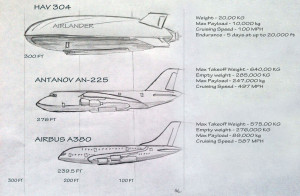Introducing Innovation in Aviation – The Airlander
Media frenzy has revealed the world’s largest aircraft, the Airlander, to the international community. It is safe to say that technology has come a long way! The Airlander is designed to be the safest form of travel. This hybrid blimp-like product is supposedly able to land on any reasonably flat surface. It consists of enough power and range to face the most toughest environments and situations. The helium-filled HAV 304 Airlander is a combination between an airship, a plane, a helicopter and a hovercraft. It is able to stay aloft for up to an incredible three weeks, carrying a weight of up to approximately 10,000 kilograms. It possesses the ability to touch down on land, water or ice. This will transform the way we travel around the world, paving the way for innovation in aviation.
The Airlander has brought about further research into the investigation of greener flying. British aviation are aiming to take a stance at providing the next generation with more efficient and environmentally friendly low-carbon aircrafts. This keeps Britain at the cutting edge of new technology, literally creating history in their own backyard. There are several unique features that stand out in the Airlander. The fact that it has the capability to circumnavigate nonstop twice around the globe demonstrates the extent of today’s technology. It owns the ability to transform the world’s response to international disasters. Manufacturer, Hybrid Air Vehicles, have stressed its promise in effective deliverance of humanitarian aid, administrative communications, broadcasting sports events and high-tech surveillance. Essentially, a multi-purpose product!
The 1930s saw the last time an airship ever took to the skies. This was following the Hindenburg disaster at Lakehurst, New Jersey on May 6th, 1937. The Hindenburg disaster brought a sudden end to the era of airships. Thirty-five passengers on board the flight were killed along with one crewman on the ground. The cause of the disaster is still unknown, however, there are several potential theories that define the cause. But none were confirmed. There are claims that the airship had been hit by lightning but many believe that the highly flammable hydrogen metal frame was the cause. The Hindenburg emerged as the airship that paved the way for travel in the future. During the 1930s, crossing the Atlantic Ocean was considered risky business. Initially, aircrafts were constructed to only travel short distances, bearing a minimal weight and needed constant refuelling. Being built over 100 years ago, the Hindenburg remained the first of many airships that would be flown across the world.
Since the Hindenburg disaster, there hasn’t been an airship, as great as the Hindenburg that has taken to the skies with such prominence. With the promising outlook of the Airlander, one would wonder if history may repeat itself. Even though technology has come a long way since the 1930s, it doesn’t necessarily guarantee aviation success without a few aeronautical flaws. Nonetheless, this is the greatest advancement in aeronautics we have seen in a while. The Airlander is a state of the art product manufactured to lead the world in the field of aviation. With the anticipation of carrying passengers in 2016, the Airlander is set to revolutionize the world of global travel, setting absolute high standards for fellow airliners. The future is in store for a fascinatingly new mode of air transport.




